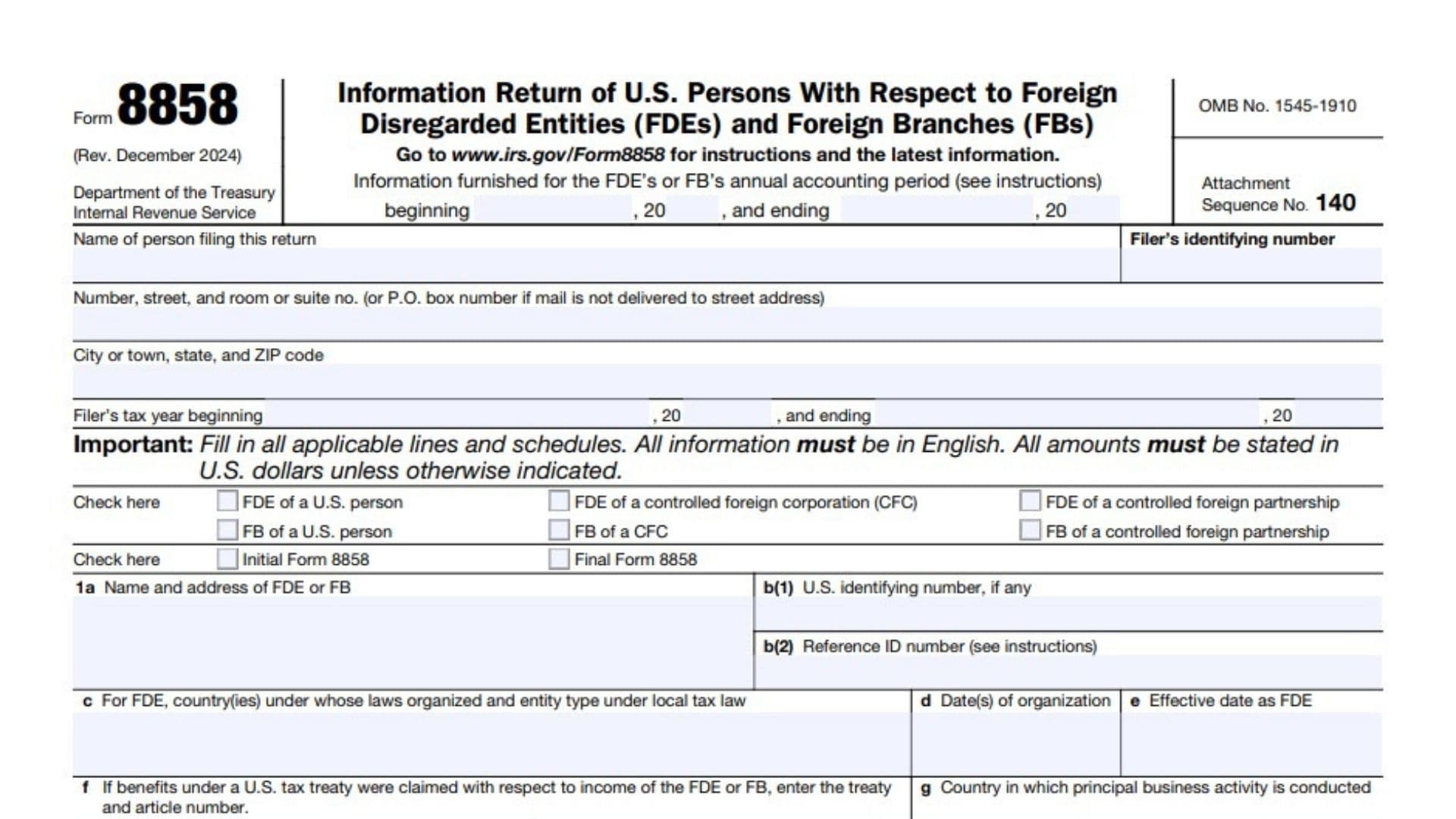IRS Form 8858, “Information Return of U.S. Persons With Respect to Foreign Disregarded Entities (FDEs) and Foreign Branches (FBs),” is a specialized tax form that U.S. taxpayers must file if they own or are tax owners of certain foreign disregarded entities or operate foreign branches. An FDE is a foreign entity that is disregarded as separate from its owner for U.S. tax purposes, while an FB is a branch or division of a U.S. person located outside the United States. The form is required to provide detailed information about the foreign entity or branch, including its structure, income, assets, activities, and taxes paid or accrued. The purpose is to ensure transparency and proper reporting of foreign operations, prevent tax avoidance, and comply with anti-deferral rules. Form 8858 must be filed annually and attached to the taxpayer’s federal income tax return. Failure to file can result in significant penalties and may impact the ability to claim certain tax benefits or credits. The form is comprehensive and must be completed for each FDE or FB, with all amounts stated in U.S. dollars unless otherwise indicated, and all information provided in English12.
How to File Form 8858?
- Attach Form 8858 to your federal income tax return (e.g., Form 1040, 1120, 1065, or 1120S).
- File a separate Form 8858 for each FDE or FB.
- Submit the form by the due date (including extensions) of your tax return.
- Provide all required schedules and supporting documentation, including an organizational chart if applicable.
- Keep copies for your records and be prepared to provide additional information if requested by the IRS.

How to Complete Form 8858?
Top Section – General Information
- Name of person filing this return: Enter your full legal name (or entity name if a business).
- Filer’s identifying number: Enter your Social Security Number (SSN), Employer Identification Number (EIN), or Individual Taxpayer Identification Number (ITIN).
- Number, street, and room or suite no. (or P.O. box): Provide your complete mailing address.
- City or town, state, and ZIP code: Enter your city, state, and ZIP code.
- Filer’s tax year beginning/ending: Fill in the start and end dates of your tax year.
Check the appropriate box:
- FDE of a U.S. person
- FDE of a controlled foreign corporation (CFC)
- FDE of a controlled foreign partnership
- FB of a U.S. person
- FB of a CFC
- FB of a controlled foreign partnership
- Initial Form 8858 (if this is your first filing for the entity/branch)
- Final Form 8858 (if this is your last filing for the entity/branch)
Line 1 – FDE or FB Identification
- 1a. Name and address of FDE or FB: Enter the full legal name and address of the foreign disregarded entity or branch.
- 1b(1). U.S. identifying number, if any: Enter the EIN or other U.S. tax ID if available.
- 1b(2). Reference ID number: If no U.S. ID, assign a unique reference ID (see instructions).
- 1c. For FDE, country(ies) under whose laws organized and entity type under local tax law: Specify the country and local entity type.
- 1d. Date(s) of organization: Enter the date the FDE or FB was organized.
- 1e. Effective date as FDE: Enter the date the entity became disregarded for U.S. tax purposes.
- 1f. If benefits under a U.S. tax treaty were claimed: Enter the treaty and article number.
- 1g. Country in which principal business activity is conducted: Specify the country.
- 1h. Principal business activity code number: Use the IRS activity code.
- 1i. Principal business activity: Describe the main business activity.
- 1j. Functional currency: Enter the functional currency (e.g., U.S. dollar, euro).
Line 2 – U.S. Branch/Agent and Bookkeeping Details
- 2a. Name, address, and identifying number of U.S. branch office or agent (if any): Provide details if applicable.
- 2b. Name and address of person(s) with custody of books and records, and location if different: List the responsible party and address.
Line 3 – Tax Owner Information (if different from filer)
- 3a. Name and address: Enter the tax owner’s details.
- 3b. Annual accounting period covered by the return: Specify the period.
- 3c(1). U.S. identifying number, if any: Enter the tax owner’s U.S. ID.
- 3c(2). Reference ID number: If applicable.
- 3d. Country under whose laws organized: Specify the country.
- 3e. Functional currency: Enter the currency.
Line 4 – Direct Owner Information (if different from tax owner)
- 4a. Name and address: Enter the direct owner’s details.
- 4b. Country under whose laws organized: Specify the country.
- 4c. U.S. identifying number, if any: Enter the direct owner’s U.S. ID.
- 4d. Functional currency: Enter the currency.
Line 5 – Organizational Chart
- Attach an organizational chart showing the name, placement, ownership percentage, tax classification, and country of all entities in the ownership chain between the tax owner and the FDE or FB, and between the FDE or FB and any entity in which it owns 10% or more (directly or indirectly).
Schedule C – Income Statement
Report all information in functional currency and U.S. dollars. If using the average exchange rate under section 989(b), check the box.
- 1. Gross receipts or sales (net of returns and allowances): Enter in both currencies.
- 2. Cost of goods sold: Enter in both currencies.
- 3. Gross profit (subtract line 2 from line 1): Enter in both currencies.
- 4. Dividends: Enter in both currencies.
- 5. Interest: Enter in both currencies.
- 6. Gross rents, royalties, and license fees: Enter in both currencies.
- 7. Gross income from performance of services: Enter in both currencies.
- 8. Foreign currency gain (loss): Enter in both currencies.
- 9. Other income: Enter in both currencies.
- 10. Total income (add lines 3 through 9): Enter in both currencies.
- 11. Total deductions (exclude income tax expense): Enter in both currencies.
- 12. Income tax expense: Enter in both currencies.
- 13. Other adjustments: Enter in both currencies.
- 14. Net income (loss) per books: Enter in both currencies.
Schedule C-1 – Section 987 Gain or Loss Information
- 1. Remittances from the FDE or FB: State in FDE/FB and recipient’s functional currencies.
- 2. Section 987 gain (loss) recognized by recipient: Enter in both currencies.
- 3. Section 987 gain (loss) deferred under Reg. 1.987-12 (attach statement): Enter in both currencies.
- 4. Were all remittances from the FDE or FB treated as made to the direct owner? Check Yes or No.
- 5. Did the tax owner change its method of accounting for section 987 gain or loss? If Yes, attach a statement describing the old and new methods.
Schedule F – Balance Sheet
Report all amounts in U.S. dollars.
Assets:
- 1. Cash and other current assets: Enter beginning and end of period balances.
- 2. Other assets: Enter beginning and end of period balances.
- 3. Total assets: Enter beginning and end of period totals.
Liabilities and Owner’s Equity:
- 4. Liabilities: Enter beginning and end of period balances.
- 5. Owner’s equity: Enter beginning and end of period balances.
- 6. Total liabilities and owner’s equity: Enter beginning and end of period totals.
Schedule G – Other Information
Answer Yes or No to each question:
- Did the FDE or FB own an interest in any trust?
- Did the FDE or FB own at least a 10% interest, directly or indirectly, in any foreign partnership?
- (If FDE elected disregarded status this year) Did the tax owner claim a loss with respect to stock or debt as a result?
- Did the FDE or FB pay or accrue any foreign tax disqualified for credit under section 901(m)?
- Did the FDE or FB pay/accrue foreign taxes to which section 909 applies, or treat previously suspended taxes as no longer suspended?
- Is the FDE or FB a qualified business unit under section 989(a)?
(If not an individual owner, answer 7–14):
7a. Did the FDE or FB receive/accrue any base erosion payment under section 59A(d) or have a base erosion tax benefit under section 59A(c)(2) from a related foreign person? If Yes, complete 7b–7c.
- 7b. Enter total base erosion payments.
- 7c. Enter total base erosion tax benefit.
8a. Did the FDE or FB pay/accrue any base erosion payment under section 59A(d) or have a base erosion tax benefit under section 59A(c)(2) to a related foreign person? If Yes, complete 8b–8c.
- 8b. Enter total base erosion payments.
- 8c. Enter total base erosion tax benefit.
- (If tax owner is a CFC) Were there any intracompany transactions in which the FDE/FB acted as a manufacturing, selling, or purchasing branch?
(If tax owner is a U.S. corporation, answer 10–14):
10a. Is the FB or FDE interest a separate unit (not part of a combined separate unit) with a dual consolidated loss?
- 10b. If Yes, enter the dual consolidated loss amount.
11a. If part of a combined separate unit, does the unit have a dual consolidated loss? If Yes, complete 11b–11c.
- 11b. Enter the loss for the combined unit.
- 11c. Enter net income (loss) attributed to the individual FB or FDE.
12a. Was any dual consolidated loss on 10b or 11b used in computing U.S. taxable income? If Yes, go to 12b.
- 12b. Was this a permitted domestic use? If Yes, go to 12c; if No, go to 12d.
- 12c. Is required documentation for permitted use attached?
- 12d. If not permitted, was the loss used to compute consolidated taxable income? If Yes, go to 12e.
- 12e. Enter the separate unit’s contribution to cumulative consolidated taxable income as of the beginning of the tax year.
13a. Did any triggering event occur requiring recapture of any dual consolidated loss in prior years?
- 13b. If Yes, enter the total recapture amount.
14a. Did the FDE or FB pay or accrue any Top-up Tax?
- 14b. If Yes, enter the amount for each type:
- (1) Income Inclusion Rule (IIR) or similar taxes
- (2) Qualified Domestic Minimum Top-up Tax (QDMTT) or similar taxes
- (3) UTPR or similar taxes
Schedule H – Current Earnings and Profits or Taxable Income
Enter all amounts in functional currency:
- Current year net income (loss) per foreign books of account
- Total net additions
- Total net subtractions
- Current earnings and profits (or taxable income) (line 1 + line 2 – line 3)
- DASTM gain (loss) (if applicable)
- Combine lines 4 and 5
- Current earnings and profits (or taxable income) in U.S. dollars (line 6 translated at average exchange rate under section 989(b))
- Enter exchange rate used for line 7
Schedule I – Transferred Loss Amount
See instructions for who must complete.
- Were any assets of an FB (including an FDE) transferred to a foreign corporation? If No, stop. If Yes, go to 2.
- Was the transferor a domestic corporation that transferred substantially all assets of an FB (including an FDE) to a specified 10%-owned foreign corporation? If No, stop. If Yes, go to 3.
- Immediately after the transfer, was the domestic corporation a U.S. shareholder of the transferee? If No, stop. If Yes, go to 4.
- Enter the transferred loss amount included in gross income as required under section 91.
Schedule J – Income Taxes Paid or Accrued
| (a) Country or territory | (b) Foreign tax year (YYYY-MM-DD) | (c) Foreign currency | (d) Conversion rate | (e) U.S. dollars | (f) Foreign branch | (g) Passive | (h) General | (i) Other |
|---|---|---|---|---|---|---|---|---|
| Enter for each country/territory: all foreign income taxes paid or accrued, currency, conversion rate, and U.S. dollar equivalent; allocate to the correct tax credit category. | ||||||||
| Totals: Sum all columns. |
